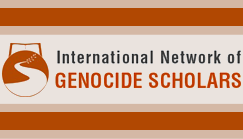Submission Type
Poster
Abstract
At the start of this project stood the supposition that news media frame issues and actors in ways which convey and underscore particular aspects thereof, and which lead media consumers to think about these issues and actors, and their potential implications and ramifications, in particular ways, including in cases of genocide and mass atrocity. Further, this happens through a gendered lens which ‘others’ women actors. A recent case in which a woman’s public image has undergone significant change and received considerable media coverage throughout is that of Aung San Suu Kyi, de factor head of state of Myanmar, and unexpectedly silent on the ongoing Rohingya crisis.
This project set out to illuminate how Aung San Suu Kyi is portrayed in internationally read news media, specifically the New York Times, Washington Post, The Guardian, The Atlantic, and Al Jazeera, between 2015 and 2018. Using a theoretical framework of framing theory, the gendered mediation thesis, and critical perspectives on victims, bystanders, perpetrators, and ‘hero’ figures in the context of genocide and mass atrocity, a framing analysis using the four groups as its organizing structure was conducted. It was found that Aung San Suu Kyi is predominantly cast as a passive bystander who is morally complicit to the persecution and has significant though not unlimited authority in Myanmar, but is discussed in the context of all four groups. She is portrayed in a gendered manner to some extent, as her elevation and demise are amplified by gendered descriptions, often drawing from feminine stereotypes and expectations, and relations to men. Predominantly, the media reconciles opposing images of her arguing either that Aung San Suu Kyi was never a hero to begin with without calling the concept of ‘hero’ into question, or by critiquing this concept.
Making and Unmaking a Hero: Aung San Suu Kyi in the News Media
At the start of this project stood the supposition that news media frame issues and actors in ways which convey and underscore particular aspects thereof, and which lead media consumers to think about these issues and actors, and their potential implications and ramifications, in particular ways, including in cases of genocide and mass atrocity. Further, this happens through a gendered lens which ‘others’ women actors. A recent case in which a woman’s public image has undergone significant change and received considerable media coverage throughout is that of Aung San Suu Kyi, de factor head of state of Myanmar, and unexpectedly silent on the ongoing Rohingya crisis.
This project set out to illuminate how Aung San Suu Kyi is portrayed in internationally read news media, specifically the New York Times, Washington Post, The Guardian, The Atlantic, and Al Jazeera, between 2015 and 2018. Using a theoretical framework of framing theory, the gendered mediation thesis, and critical perspectives on victims, bystanders, perpetrators, and ‘hero’ figures in the context of genocide and mass atrocity, a framing analysis using the four groups as its organizing structure was conducted. It was found that Aung San Suu Kyi is predominantly cast as a passive bystander who is morally complicit to the persecution and has significant though not unlimited authority in Myanmar, but is discussed in the context of all four groups. She is portrayed in a gendered manner to some extent, as her elevation and demise are amplified by gendered descriptions, often drawing from feminine stereotypes and expectations, and relations to men. Predominantly, the media reconciles opposing images of her arguing either that Aung San Suu Kyi was never a hero to begin with without calling the concept of ‘hero’ into question, or by critiquing this concept.





Comments
View Astrid Juckenack's bio.